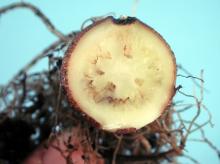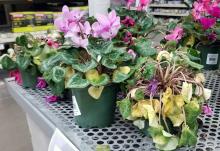Cause Fusarium oxysporum f. sp. cyclaminis, a soilborne fungus that causes a vascular wilt of cyclamen. It can be transmitted by seed (or debris associated with the seed) or from plant to plant by overhead watering, contaminated tools, or infested soil. Transmission by shoreflies or fungal gnats is suspected but has not been definitively proven. More plants become infected in an ever-widening circle as the pathogen is moved around. Disease severity is a function of inoculum load. It can survive in contaminated growing media or Styrofoam propagation trays. It survives in the soil as thick-walled, dormant chlamydospores, which germinate in response to exudates from nearby plant roots. Hyphae then penetrate the roots, colonize the cortex, and move into the xylem tissue. Small spores (microconidia) are produced and carried up into the plant. Sphagnum peat media favor disease development. It will not affect different plants grown in the same greenhouse. Temperatures above 70°F favor the disease, which may occur in 2 to 4 weeks. However, at 60°F symptoms may not show for 7 weeks. Drought stress can increase symptom development.
The use of sodium chloride has been reported to have growth benefits but was not effective for disease control.
Symptoms Aboveground symptoms include a bright yellowing and wilting first on lower leaves, then on the rest of the plant. Older plants develop chlorotic patches on the leaf blade of at the leaf edge. The corm does not get soft and mushy as with bacterial soft rot, but in cross-section shows patches of reddish-brown to black, or purple, discoloration in the vascular system. Roots exhibit vascular discoloration and may be totally discolored and darkened. Any growth stage is susceptible to infection, wilt, and death. If growing conditions are good, plants may be symptomless until hot weather, heat stress, or flowering occur.
Cultural control A strict sanitation program with regular scouting and quick removal of infected plants is critical to overall production.
- Remove and destroy infected plants as they develop. Scout plants at least once a week.
- Discard or sterilize contaminated media.
- Clean bench surfaces with steam or disinfectants.
- Use composted bark media, which suppress this fungus.
- Adjust growing medium pH to 6.5 to 7.
- Shade and cool the greenhouse in summer.
- Use drip-tubes, capillary mats, or ebb and flow systems rather than overhead irrigation.
- Use nitrate nitrogen when fertilizing instead of ammoniacal nitrogen.
Chemical control Not effective as a sole treatment but must be integrated with cultural controls and/or biologicals. Even then, losses still will occur. Use these materials preventively only. Do not use to salvage the crop, as treatments are generally ineffective and only help increase the risk of developing resistant fungi.
- Cleary's 3336 EG at 8 to 16 oz/100 gal water as a drench after seeding or transplanting. Not quite as good as other products. Group 1 fungicide. 12-hr reentry.
- Heritage at 1 to 4 oz/100 gal water plus a non-silicone-based wetter sticker. Group 11 fungicide. 4-hr reentry.
- Insignia SC at 6 to 12 fl oz/100 gal water. Do not use with organosilicate-based adjuvants. Use preventively only. Group 11 fungicide. 12-hr reentry.
- Medallion WDG at 1 to 2 oz/100 gal water has been effective in some trials depending on disease pressure. Use with oils or adjuvants may damage plant. Group 12 fungicide. 12-hr reentry.
- Orkestra at 8 to 10 fl oz/100 gal water. Group 7 + 11 fungicide. 12-hr reentry.
- Pageant at 12 to 18 oz/100 gal water. Do not use with organosilicone-based adjuvant. Group 7 + 11 fungicide. 12-hr reentry.
- Postiva at 10 to 28 fl oz/100 gal water as a drench. Group 3 + 7 fungicide. 12-hr reentry.
- Terraguard SC at 4 to 8 fl oz/100 gal water. Group 3 fungicide. 12-hr reentry.
Note Compass may be phytotoxic.
Although Broadform was found to be effective it is not allowed for drench application and Cyclamen is not on the label.
Biological control Use in conjunction with other control tactics such as thorough sanitation and chemicals. Biologicals alone do not provide adequate protection against this disease and, at best, may only delay symptom expression. Use after chemical protection.
- LALStop G46 WG (Clonostachys rosea [formerly Gliocladium catenulatum] strain J1446) at 0.33 oz/5 gal water. Do not use with other products in the tank.4-hr reentry. O
- LALStop K61 WP (Streptomyces Strain K61) at 0.07 oz/100 to 200 sq ft. Apply with enough water to move product into the root zone. Can be used as a soil spray, drench, dip or incorporated into potting media. 4-hr reentry. O
- Mycostop (Streptomyces Strain K61) at 1 to 2 grams/100 sq ft. Apply with enough water to move product into the root zone. Can be used as a soil spray, drench, dip or incorporated into potting media. 4-hr reentry. O
- Obtego (Trichoderma asperellum and T. gamsii) at 2.5 to 7.5 oz/100 gal water as a drench. Not compatible with several fungicides. Poor efficacy. 4-hr reentry. O
References Elmer, W.H. 2002. Influence of inoculum density of Fusarium oxysporum f. sp. cyclaminis and sodium chloride on cyclamen and the development of fusarium wilt. Plant Disease 86:389-393.
Elmer, W.H. and McGovern, R.J. 2004. Efficacy of integrating biologicals with fungicides for the suppression of fusarium wilt of cyclamen. Crop Protection 23:909-914.



